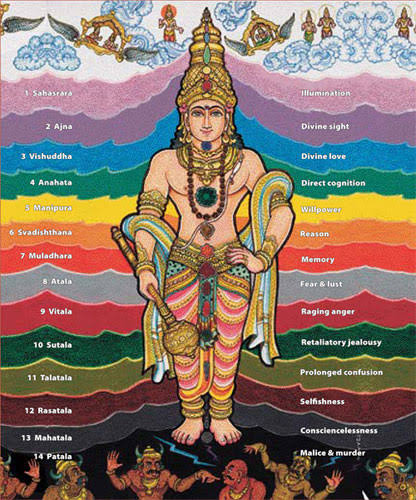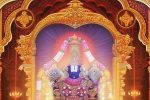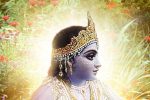NAME 61
Trikakubdhāma त्रिककुब्धाम
He is the supporter of the three States of Consciousness
There are three words in this name – tri, kakub or kakut, and dhaama, Viz.
tri means three;
kakub means the direction or kakut means the hump (such as the hump on the back of a bull, camel, or a peak or mountain) or horn of an animal; or kakub and kakut also are interchangeably used for either meaning and
dhaama means abode or residence, and also a ray of light or brilliance.
Several interpretations arise depending on which of the meanings one picks.
Sri Adi Sankara gives the interpretation that He is the base or support for the three regions of the entire space, the upper, the lower, and the middle, and therefore He is tri-kakub-dhaama.
Swami ChinmayAnanda gives the Vedantic interpretation that He is the base or support for the three states of consciousness, viz., the jaagrat, svapna, and sushupti (the awaker, the dreamer and the sleeper) and this is why He is called tri-kakub-dhaama.
Sri Bhattar gives the interpretation that tri-kakub-dhaama means One who has His abode as the Parama-Pada, which is thrice as large as this Universe. Sri Bhattar also gives an alternative possibility of taking Trikakut and Dhaama as 2 different words.
varahaTri-kakut refers to the incarnation of Bhagavaan as the Varaaha, the Boar with three horns. This interpretation for tri-kakut is supported by the following Shloka from Moksha Dharma in the Mahaa Bhaarata
‘tathaiva aasam tri-kakudo varaaham roopam aasthitah |
trikakut tena vikhyaatah Shareerasya pramaapanaat || (moksha dharma 343-63)’
Meaning: “Then I assumed the form of a Boar with three horns. So I became known as ‘tri-kakut’. In that form I killed the raakshasa (Hiranyaaksha).”
Dhaama will be a separate Nama meaning the effulgent one. But this interpretation is offered only as a possibility.
६१. ॐ त्रिककुब्धाम्ने नमः |
61. OM Trikakubdhāmne Namaḥ
Tri-kakub-dhaama -One who is the very foundation or support (Dhaama) of the three (“tri”) quarters (Kakubh). We find this is generally commented upon and described as “all quarters, in the three realms above, below and middle.” Viewing this from the platform of Vedanta, He must be considered by us as the three Planes-of -Consciousness-the waking (Jaagrat), the dream (Svapna) and the deep-sleep (Sushupti) conditions. The fourth Plane-of-Consciousness (Tureeya) is
Ūrdhvādhomadhyabhedena) Tisr̥ṇāṃ kakubhāṃ (api) dhāma
His abode is above, below and the middle regions.
Śrīmad Bhāgavata – Canto 6, Chapter 9
Tri-bhuvanātma-bhavana trivikrama tri-nayana tri-loka-manoharānubhāva tavaiva vibhūtayo ditijadanujādayaścāpi teṣām upakrama samayo’yam iti svātma māyayā sura nara mṛga miśrita jalacarākṛtibhir yathāparādhaṃ daṇḍaṃ daṇḍadhara dadhartha evam enam api bhagavañjahi tvāṣṭram uta yadi manyase. (40)
You are the Supersoul of the three worlds whose power and opulence is distributed throughout the three worlds; O maintainer and seer of the three worlds who is perceived as the most beautiful within the three worlds. Everything and everyone, including human beings and even the Daitya demons and the Dānavas are but an expansion of Your energy. O supremely powerful one, You have always appeared in Your forms as the various incarnations to punish the demons as soon as they become very powerful. You appear as Lord Vāmanadeva, Lord Rāma and Lord Kṛṣṇa. You appear sometimes as an animal like Lord Boar, sometimes a mixed incarnation like Lord Nṛsiḿhadeva and Lord Hayagrīva, and sometimes an aquatic like Lord Fish and Lord Tortoise. Assuming such various forms, You have always punished the demons and Dānavas. We therefore pray that Your Lordship appear today as another incarnation, if You so desire, to kill the great demon Vṛtrāsura.
ॐ भूर् भुवः स्वः
तत् सवितुर्वरेण्यं
भर्गो देवस्य धीमहि
धियो यो नः प्रचोदयात्
Om bhūr bhuvaḥ suvaḥ
tatsaviturvareṇyaṃ
bhargo devasyadhīmahi
dhiyo yo naḥ prachodayāt
We meditate on the glory of the Creator;
Who has created the Universe;
Who is worthy of Worship;
Who is the embodiment of Knowledge and Light;
Who is the remover of all Sin and Ignorance;
May He enlighten our Intellect.
Gayatri Mantra meaning
O, Divine mother, our hearts are loaded up with darkness. Kindly make this darkness distant from us and advance brightening inside us.
Lord Vishnu takes care of protecting the created universe. Being the protector of the worlds, Lord Vishnu is the most merciful Lord who blesses His devotees with peace, prosperity and auspiciousness.
INTERPRETATION GUIDED BY SANT VANI (WORDS OF SAINTS)
Trikakubdhāma
The abode of the three regions.
He who is ultimate support for the three worlds. He who supports the lower, middle, and upper regions. The supreme supporter of the three states of existence/consciousness. What exists in the macrocosm exists in the microcosm within the human body.
Some of us feel at home, at home. Some of us feel at home with people we are close to. This feeling ‘at home’ translates into being ourselves, feeling safe, protected and powerful. We recognise that we are totally acceptable. No need for masks. How much nicer it would be if we could feel at home anywhere we are? Being at home is recognizing that wherever I am, whatever I do, whoever I relate to, I am always in the presence of Īśvara. There is never a time or place that I am without Īśvara’s presence. If this is not in my awareness, I bring it to my awareness.
“Falling in love is nothing more than discovering where or to whom you belong.” – Om Swami
https://os.me/building-a-sense-of-belonging/
That’s it. I do not need to be judgmental any which way. Trikakubdhāma is one word to reveal the Lord. Ka kub means a direction or region. He is the dhāma, the abode of the three ka kubs, the regions that are ūrdhva–above, adhaḥ–below and madhya–in the middle. Not just present in a temple or puja corner, the Lord is all-pervasive.
Dhāma also means support. Thus, He is also the support of all the three regions.
The three regions are the three spheres of experiences, that is, the higher or celestial experiences, the lower or animal experiences and the middle or human experiences. All these possible experiences are within Īśvara alone, because there can be no experience outside Īśvara.
Again viewed contextually and as a continuum of meaningful beads strung together, we see that this name has to necessarily refer to ‘him’ as that person who can bestow upon his devotees that state of supreme consciousness which is called Turīya (तुरीय) – that is what he who is the Prabhūtāḥ (प्रभूता:) the owner of the supreme treasure-house can offer to those who place their trust in him and take him as their only support and guide.
As the eternal witness, he is the silent observer sitting behind that veil of Māyā, that pure consciousness – beyond the three states of normal human consciousness – Jagrat Avastha (waking state), Svapna Avastha (Dream state), and Sushupti Avastha (Deep sleep) – as that Turīya (तुरीय) who forms the basis for these three states of existence – the state where the ‘Self” recognizes its true nature and the outgoing senses are withdrawn deep within and the individual is neither awake nor asleep and no longer struggling under the delusion of what his true nature is – when the illusion of ‘separateness‘ between the Ātman and the Paramātmān is removed and the journey of the “lone” to the ‘alone‘ is completed.
Attaining to the state of Turīya is in reality attaining him – The Supreme Higher Self – Tripura – that is the real wealth that he as the Prabhūtāḥ (the previous name in this string) offers.
In Chapter-2; verse-69 of the Bhagavad-gītā, Bhagawan shares with Arjuna a glimpse of what it means to enter into that state of knowledge where one understands the true purpose of life:
या निशा सर्वभूतानां तस्यां जागर्ति संयमी |
यस्यां जाग्रति भूतानि सा निशा पश्यतो मुने: || 2-69||
yā niśhā sarva-bhūtānāṁ tasyāṁ jāgarti sanyamī
yasyāṁ jāgrati bhūtāni sā niśhā paśhyato muneḥ
That which appears dark as the night (yā niśhā), to most people (sarva-bhūtānāṁ), to that Self – A centered sage appears as the bright day and he stays awake and vigilant (जागर्ति संयमी); and that which is day to most people (यस्यां जाग्रति भूतानि), the wise one sees as the night and goes into quiet contemplation (निशा पश्यतो मुने:)…
The Mandukya Upaniṣhad, one of the smallest of the Upaniṣhads uses the analogy of ‘Om’ (ओम्) using the syllables Aum to describe the first three states of consciousness and then describes the state of Turīya thus:
अमात्रश्चतुर्थोऽव्यवहार्यः प्रपञ्चोपशमः शिवोऽद्वैत एवमोङ्कार आत्मैव संविशत्यात्मनाऽऽत्मानं य एवं वेद ॥ १२ ॥
amātraścaturtho’vyavahāryaḥ prapañcopaśamaḥ śivo’dvaita evamoṅkāra ātmaiva saṃviśatyātmanā”tmānaṃ ya evaṃ veda || 12 ||
That which has no parts (soundless) or identity, is incomprehensible by the senses, is reached only by transcending the senses, that which leads to the bliss of absolute non-duality, that soundless is the fourth aspect of Aum and verily the same as the Ātman. He who knows this merges his self in the Self beyond the three modes of material nature and the three planes of existence or maha vyahritis- Bhur Bhuva Swah. Bhur: the physical body/physical realm; Bhuvah: the life force/the mental realm Suvah: the soul/spiritual realm. The one who goes beyond the triputi and maintains a sambhaav – mental equipoise in all conditions, such a person becomes endowed with the shad bhag – he becomes PrabhūstriTrikakubdhama
Please Watch
We must throughout the Vishnu Sahasranama remember that these beautifully woven string of Bhagwan’s names are being said by Bhishma Pitamah – a man on his death bed loaded with a lifetime of wisdom and his truth imparting the supreme gyana to Yudhishthir in the presence of Bhagwan himself. Why wait till death to discover your “Hiraeth“? Wake up!!! Time is running out.
Now is the only Śāśvataḥ. (refer to the previous name in the string). It’s now or never.



